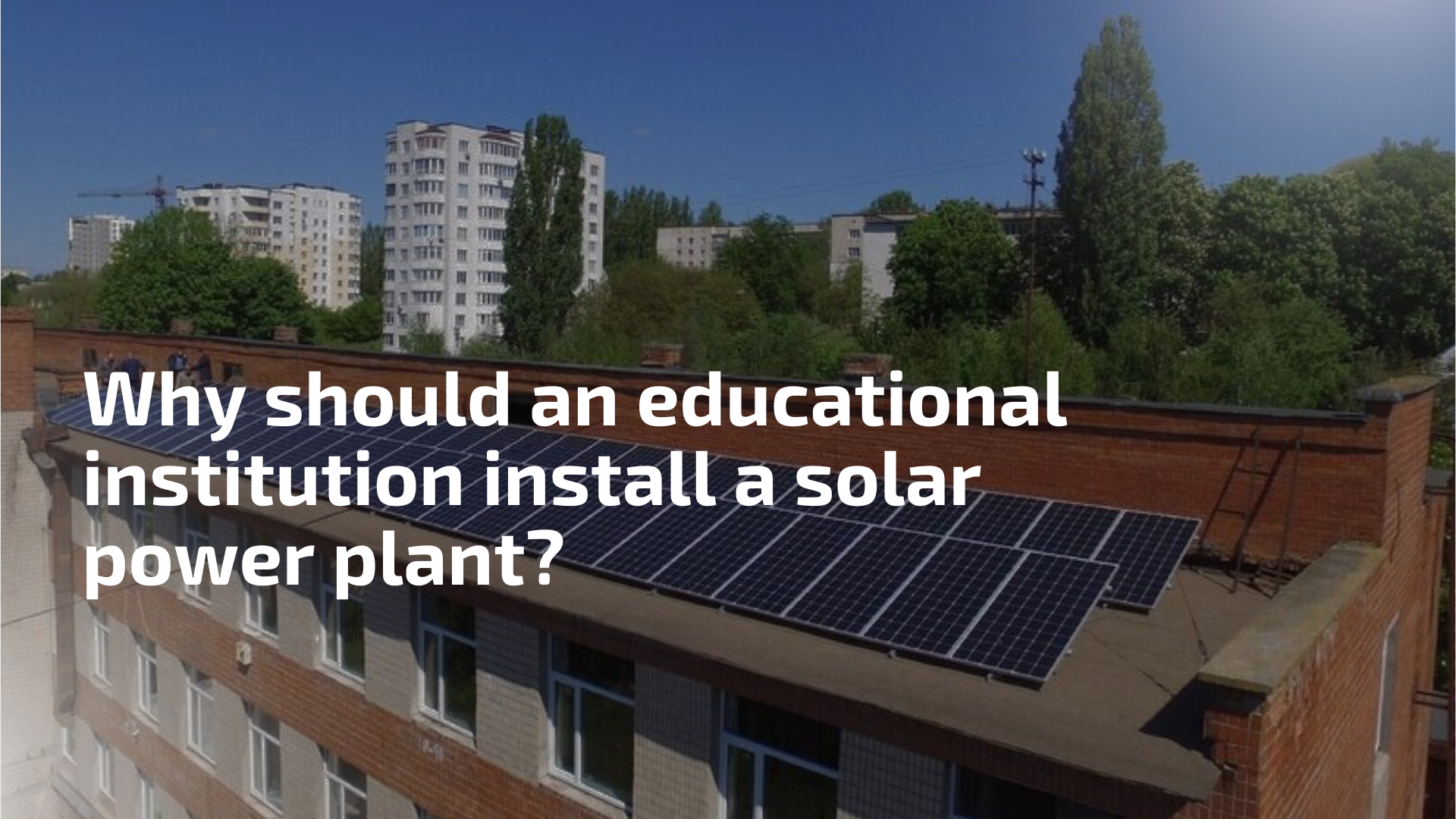While pupils are on holiday, educational institutions are preparing for the new school year and planning how to ensure a stable power supply. Solar power plants (SPPs) may be useful for this purpose – they will increase energy security, do not require constant maintenance, save money on electricity bills and can become part of the educational process.
Why should an educational institution install a solar power plant?
For the energy security of educational institutions
Power outages can cause interruptions in education. SPPs with batteries will provide more stable power supply to educational institutions, so teachers and professors will have access to the Internet and will be able to power the equipment necessary for learning for a certain period of time. Thanks to SPPs, educational institutions become less dependent on centralized energy sources, which is especially important in remote areas or in emergency situations.
A hybrid or autonomous solar power plant with batteries can power gas or solid fuel boilers that cannot operate without electricity. The batteries will ensure uninterrupted heating of the building in the absence of power supply from the general grid. It is important to note that a high-quality technical solution must be developed at the design stage of a SPP.
To save budget funds
A significant advantage of a solar power plant is that it saves money on utility bills. For example, a 30 kW capacity is enough to generate a total of 30,000 kWh of electricity per year. Eight solar power plants with a total capacity of 350 kW have been installed on the roofs of the educational buildings of Khmelnytsky National University, which can save more than UAH 4 million a year.
The 25.6 kW hybrid solar power plant installed at Irpin Lyceum No. 1 saves more than UAH 50,000 per year. And thanks to batteries with a capacity of 40 kWh, the lyceum can operate autonomously for up to 4 hours.
Institutions with installed solar power plants can use the ‘self-production mechanism’. It allows them to supply excess electricity to the grid and receive funds credited to a special account. They can be used when the SPP does not cover all the needs and the institution uses electricity from the grid. In other words, thanks to the ‘self-production mechanism’, the institution will compensate for its cost.
For the educational process
SPPs can become not only a source of energy but also an educational tool. Their operation will raise the environmental awareness of pupils and students and contribute to the formation of sustainable environmental values. Participants of the educational process will be involved in research, gain practical knowledge and skills that are important for professional development in the field of renewable energy.
For example, Lviv Polytechnic has set up a specialised laboratory based on a solar power plant, where students study the operation of modern energy systems, their installation and commissioning.
A similar project was implemented in Khmelnytskyi as part of the grant competition of the Ecoclub and Ecoaction, funded by the European Union. NGO Khmelnytskyi Energy Cluster, together with Higher Vocational School No. 25, created a training centre for solar power plant installers. For this purpose, a 5 kW solar power plant was installed on the roof of the school. It will partially cover the school’s energy consumption needs. In the future, students of the vocational school will be able to obtain the qualification of a solar power plant installer for the first time in Ukraine.
What to do with excess electricity
Typically, SPPs produce the most electricity in the summer months, when solar activity is highest. In other words, when the educational process is over. Therefore, here are some options for what to do with the excess electricity generated.
– Use the ‘self-production mechanism’. If the system is connected to the public electricity grid, the school can sell excess electricity to the supplier and receive payment for it. The details of the mechanism and how to use it are described in this publication.
– To power buildings located nearby. Surplus electricity can be transferred to neighbouring buildings if they are located nearby (the power grid line is up to 150 metres away).
– Install batteries that will accumulate the surplus. In case of power outages, they will ensure uninterrupted power supply, and at night, the surplus can be used to illuminate the territory of the institution.
– Change the mode of operation of the educational institution (start the school year earlier, operate the institution as a base during the inter-school period – camps, competitions, etc.)
What educational institutions need to do if they want to install a solar power plant
– Analyse energy consumption. It is necessary to analyse the energy consumption of the institution in detail to determine the optimal capacity of the SPP.
– Design. Contact a specialised company or organisation to develop a project for the installation of a solar power plant. Experts will determine the location for the panels, calculate their number and capacity. It is important to formulate the terms of reference correctly: if you do not inform about the need for uninterrupted operation, the station will not have batteries.
– Identify sources of project funding. The institution can attract grants, take advantage of international technical assistance programmes, or find private investors. Another option is to invest your own money.
– Install the solar power plant. Choose a licensed contractor for the installation of a solar power plant. Ecoclub experts can advise you on what to look for in order to choose qualified specialists.
– Connect to the grid. After installation, it is necessary to obtain a permit to connect to the general power grid, conclude an agreement with the energy company on the ‘self-production mechanism’ (if necessary).
– Put the SPP into operation and carry out start-up and commissioning works.
– Conclude a maintenance agreement for possible critical situations.
The Energy Act For Ukraine Foundation installs SPPs for educational institutions in Ukrainian communities. You can read the selection criteria and apply here.
Photo: ye.ua
The project ‘Renewable Energy for a Sustainable Ukraine’ is implemented by GIZ on behalf of the German Government.












